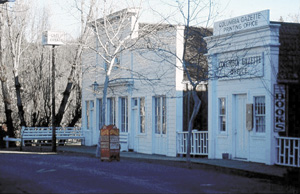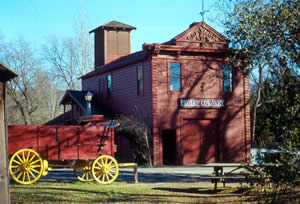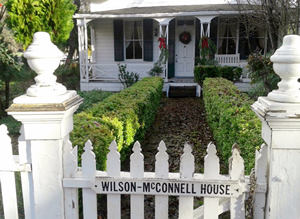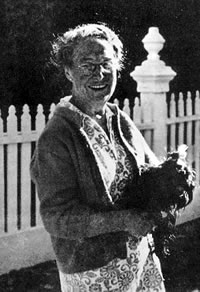Geraldine McConnell
"Time will run back and fetch the Age of Gold," the poet John Milton wrote in 1629—one ten-second encounter I had in Columbia, in Tuolumne County near Sonora, would prove this true.
Columbia is more than a wide spot in the road, it is a warm spot in the heart. For more than any other Sierra foothill community, Columbia is designed to retain its Gold Rush ambiance.
A Living Park
Columbia State Historic Park was established in 1945 to preserve and continually recapture the sights, sounds, and smells of the bygone era. Most motorized vehicles are prohibited on its tree-lined, deeply shadowed thoroughfares. Old buildings, called "historic structures" in the park literature, are painstakingly restored, replicated, or maintained in a state of arrested decay. On the 273-acre site, shops, restaurants, and hotels intertwine with the permanent residents of the town. And that is what gives Columbia an additional zest.
Unlike most Gold Rush settlements, Columbia was never completely deserted. It stayed alive and kept many of its antique edifices intact. This leads to a particularly satisfying mood. The reality and the myth combine seamlessly in Columbia. History is not just about the truth, but interpretation as well. What people think about an area or event is often as important as the cold, hard facts.
Hildreth's Diggins > American Camp > Columbia
The cold, hard facts are these. In 1850, D. Thaddeus Hildreth and a gaggle of goldseekers established a camp. They found gold and other miners soon arrived. Within days, Hildreth’s Diggins had a population exceeding one thousand. Eventually more than 6,000 would populate the narrow dirt streets. The mining camp was briefly renamed American Camp, and then permanently became Columbia. Gold totaling more than $500 million in today’s money would be mined in the "Gem of the Southern Mines."
Slowly, as placer and hydraulic mining expanded, the shanty town blossomed with wooden structures and a haphazard street plat. By 1852, more than 150 stores, shops, saloons, and schools had arisen.  In 1854, many collapsed in the wake of a disastrous fire. Like the phoenix, Columbia reemerged from the ashes. Wood was replaced by locally produced red brick, a perceptible reminder of the Gold Country’s red dirt. Thirty buildings were constructed of this solid material. Iron doors, metal window shutters, and brick roofs were added as fire protection. Water pipes for firefighting and domestic use were provided—some of the original pipes were utilized until 1950. Colorfully adorned fire engines and handpumpers became welcome and practical augmentations. A volunteer firefighter brigade was formed—Columbians loved to join, as attested to by the elaborate Masonic Lodge and a branch of the Sons of Temperance.
In 1854, many collapsed in the wake of a disastrous fire. Like the phoenix, Columbia reemerged from the ashes. Wood was replaced by locally produced red brick, a perceptible reminder of the Gold Country’s red dirt. Thirty buildings were constructed of this solid material. Iron doors, metal window shutters, and brick roofs were added as fire protection. Water pipes for firefighting and domestic use were provided—some of the original pipes were utilized until 1950. Colorfully adorned fire engines and handpumpers became welcome and practical augmentations. A volunteer firefighter brigade was formed—Columbians loved to join, as attested to by the elaborate Masonic Lodge and a branch of the Sons of Temperance.
The Decline Begins
By 1860, the placers began to give out. Columbia declined. In the decades that followed buildings were razed and the vacated lots were mined. The gravel and the population depleted. By the turn of the 20th century less than 500 residents remained.
But Columbia did not die, it hung on and on. Years passed and Columbia slept. Some historic buildings became seedy and dangerous, but nothing else changed very much. Columbia waited.
In 1945, the California State Legislature recognized a special opportunity to preserve and resurrect an authentic Gold Rush village. With an appropriation of $50,000, the Columbia State Historic Park was born. It was a healthy birth, and a very happy occasion.
Bank Guards
The Wells Fargo building guards the entrance to Main Street—a classic Gold Rush vista. So classic in fact that the street was a venue for the movie "High Noon," and television shows such as "Little House on the Prairie." Simply cover the pavement with dirt, and another era pops to life.
A leisurely stroll passes by the D.O. Mills Bank Building (1854); the Brady Building (1899); the Cheap Cash Store (1854); an old-fashioned barber shop (1865); and the New York Dry Goods Building (1855). A functioning blacksmith shop spews steam and agreeable sizzles. The Jack Douglass Saloon (1857) offers sarsaparilla and adult soda pop. Firehouse No. 1 passes by on your right. The gaudily decorated two-cylinder fire engine Papeete rests inside. Additional exhibits are sprinkled through town with helpful interpretive information—an ancient drug store, an old dentist’s office with period dental torture instruments on display, and an historic courtroom that is still used on occasion. Most interesting is an artifact-laden Chinese Herb Shop with a vivid public-address presentation in both English and Chinese.
A Personal Encounter
Years ago, on a most pleasurable visit to the town, I stopped for a moment in front of the City Hotel, a venerable 1857 structure that is often operated by resort management students from the nearby community college, Columbia College. I paused to listen to a street singer dressed in spectacular cowboy apparel—a sweeping Stetson that swallowed his ears, a bright multicolored bandanna, a pearl studded shirt, crisply ironed jeans with a crease so sharp you could cut cheese, and boots with heels so tall that he seemed ten, make that eleven, feet tall. He was singing cowboy songs, with accompanying yodels and gleeful hollers. The songs were wonderfully performed, but seemed a bit odd in a place that was never a cowboy town.
As I was soaking in the cowpoke concert, a little girl, perhaps three years old, skipped into the street and began to dance energetically to the tunes. I smiled at her frenetic antics. I heard faint giggling behind me. I turned to see from where it came. It wafted from the house across the street—the Wilson/McConnell House. I could not see the source but it was clearly from there. No doubt.
McConnell's House
The Wilson/McConnell House is a beautiful old farmhouse that is the only private residence within the downtown section of Columbia. It features an elegant wrap-around porch and a verdant garden. The house is surrounded by a crisp milky-white picket fence. Carefully trimmed hedges line the walkway to the front door, which is set back from the sidewalk about thirty feet. This house was the home of Geraldine McConnell, who was instrumental in persuading the state legislature to establish the historic park in 1945. When the dedication ceremony took place, Geraldine’s house officially became the Governor’s Mansion—for one day. Mrs. McConnell died in 2003 at the age of 99, but, on my visit long ago, Geraldine was still very much alive, as I peered through the branches and beyond the hedge to find the source of the laughter.
And then I saw her.
An old woman, frail and white-haired, was sitting on the porch in a wide-armed rocking chair sipping a glass of ice water. The glass was wrapped in a white cloth napkin bordered in red. She was rocking gently with the cowpuncher’s crooning and happily watching the tiny tot’s gyrations.
Could this be Geraldine McConnell? I knew she was still alive. I had never seen her picture. I had never met her. But it was her house. I hoped it was her.
I knew that I wasn’t supposed to disturb the residents, but I could not resist. I placed my hands atop the picket fence, leaned over, and yelled.
"Mrs. McConnell?!"
Her ears perked up and the elderly lady smiled with a mixture of puzzlement and pleasure. She nodded slightly to affirm her identity. It was Geraldine McConnell.
"Mrs. McConnell," I continued. "Sorry to disturb you. But I wanted to thank you for Columbia."
Geraldine did not say a word, but her gesture spoke volumes. She raised her water glass as if making a toast. She shook it slightly and the red-rimmed napkin waved briefly. Geraldine then replaced her glass on the broad arm of the chair. Once again in rhythm with the music, Mrs. McConnell returned to her rocking.
That was it. It was over in ten seconds. I moved on.
But as long as I live, I will recall the red-fringed napkin of the little old lady on the Columbia porch.
Image Credits:
- Columbia State Historic Park Source: Collections of the California State Parks
- Columbia Gazette and Eagle Cottage Building Source: Photo by Gary Noy
- Columbia Engine Company and McConnell house. Source: Photo by Gary Noy
- Columbia Engine Company. Source: Photo by Gary Noy
- The Wilson-McConnell House in Columbia State Historic Park, the home of Geraldine McConnell McConnell. Source: Photos by Gary Noy
- Geraldine McConnell. Source: From the Earl Warren Oral History Project, The Regents of the University of California
